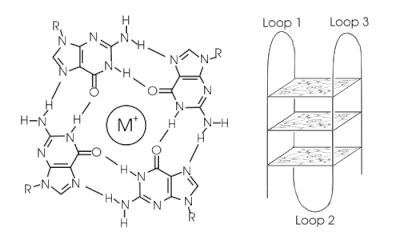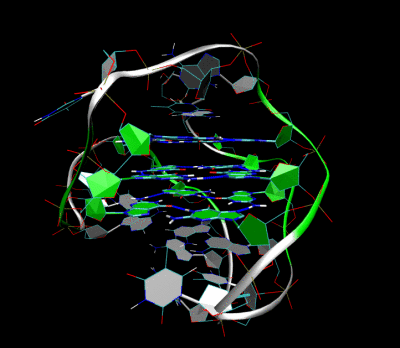G-quadruplex
Nucleic acid sequences which are rich in guanine are capable of forming four-stranded structures called G-quadruplexes (Also known as G-tetrads or G4-DNA). These consist of a square arrangement of guanines (a tetrad), stabilized by Hoogsteen hydrogen bonding. They are further stabilized by the existence of a monovalent cation (especially potassium) in the center of the tetrads. They can be formed of DNA, RNA, LNA and PNA, and may be intramolecular, bimolecular or tetramolecular. Depending on the direction of the strands or parts of a strand that form the tetrads, structures may be described as parallel or antiparallel.


Telomeric quadruplexes
Telomeric repeats in a variety of organisms have been shown to form these structures in vitro, and they have also been shown to form in vivo in some cases. The human telomeric repeat (which is the same for all vertebrates) consists of many repeats of the sequence d(GGTTAG), and the quadruplexes formed by this structure have been well studied by NMR and X-ray crystal structure determination. The formation of these quadruplexes in telomeres has been shown to decrease the activity of the enzyme telomerase, which is responsible for maintaining length of telomeres and is involved in around 85% of all cancers. This is an active target of drug discovery.
Non-telomeric quadruplexes
Recently, there has been increasing interest in quadruplexes in locations other than at the telomere. This was given a large boost by the work by Hurley on the proto-oncogene c-myc[1], which was shown to form a quadruplex in a nuclease hypersensitive region critical for gene activity. Since then, many other genes have been shown to have G-quadruplexes in their promoter regions, including the chicken β-globin gene, human ubiquitin-ligase RFP2 and the proto-oncogenes c-kit, bcl-2, VEGF, H-ras and N-ras. This list is ever-increasing.
Genome-wide surveys based on a quadruplex folding rule have been performed, which have identified 376,000 Putative Quadruplex Sequences (PQS) in the human genome, although not all of these probably form in vivo.[2] A similar study has identified putative G-quadruplexes in prokaryotes[3].There are several possible models for how quadruplexes could control gene activity, either by upregulation or downregulation. One model is shown below, with G-quadruplex formation in or near a promoter blocking transcription of the gene, and hence de-activating it. In another model, quadruplex formed at the non-coding DNA strand helps to maintain an open conformation of the coding DNA strand and enhance an expression of the respective gene.

Ligands which bind quadruplexes
One way of inducing or stabilizing G-quadruplex formation, is to introduce a molecule which can bind to the G-quadruplex structure, and a number of ligands, both small molecules and proteins, have been developed which can do so. This has become an increasingly large field of research.
A number of naturally occurring proteins have been identified which selectively bind to G-quadruplexes. These include the helicases implicated in Bloom's and Werner's syndromes and the Saccharomyces cerevisiae protein RAP1. An artificially derived three zinc finger protein called Gq1, which is specific for G-quadruplexes has also been developed, as have specific antibodies.
Quadruplex prediction techniques
Identifying and predicting sequences which have the capacity to form quadruplexes (QFP, for Quadruplex Forming Potential) is an important tool in further understanding of their role. A rule for predicting the formation has been proposed, where sequences are predicted to fold based on the pattern d(G3+N1-7G3+N1-7G3+N1-7G3+), where N is any base (including guanine). This rule has been widely used in on-line algorithms.
External links
Books
Quadruplex websites
- Quadruplex.org - a website to serve the quadruplex community
- Quadbase - downloadable data on predicted G-quadruplexes
- Greglist - a database listing potential G-quadruplex regulated genes
- Database on Quadruplex information: QuadBase from IGIB
- GRSDB- a database of G-quadruplexes near RNA processing sites.
- GRS_UTRdb- a database of G-quadruplexes in the UTRs.
- G-quadruplex Resource Site
Research papers
- In vivo veritas: Using yeast to probe the biological functions of G-quadruplexes. Johnson JE, Smith JS, Kozak ML, Johnson FB. Biochimie. 2008 Feb 21
- Prevalence of quadruplexes in the human genome, Huppert and Balasubramanian, NAR 2005 33(9) 2908-2916
- Highly prevalent putative quadruplex sequence motifs in human DNA, Todd, Johnston, and Neidle, NAR 2005 33(9) 2901-2907
- Quadruplex DNA: sequence, topology and structure, Burge, Parkinson, Hazel, Todd and Neidle, NAR 2006 34(19) 5402-5415
- Direct evidence for a G-quadruplex in a promoter region and its targeting with a small molecule to repress c-MYC transcription, Siddiqui-Jain et al, PNAS 2002 99(18) 11593-8
- Genome-wide prediction of G4 DNA as regulatory motifs: Role in Escherichia coli global regulation, Rawal P, Kummarasetti VB, Ravindran J, Kumar N, Halder K, Sharma R, Mukerji M, Das SK, Chowdhury S., Genome Res. 2006 16(5) 644-55
